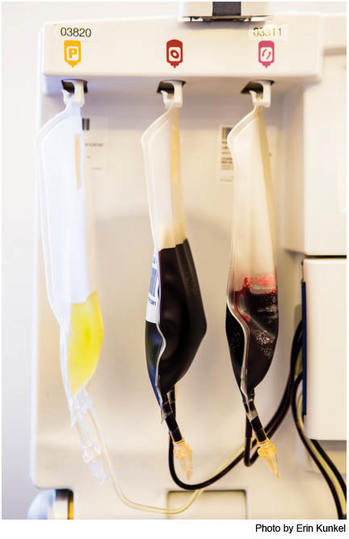Roll Up Your Sleeve: There’s Still No Substitute for Blood
By Jessica Shugart, Staff Writer for the department of Communications & Public Affairs at the Stanford School of Medicine
Most donors give blood only a few times a year, if that. But for Linda Johnson, it’s a routine part of life. On this fall day in 2012, Johnson reclines in a comfy chair at the Stanford Blood Center, wrapped in a soft, powder-blue blanket, while two pints of blood drain from a vein in her arm. Right next to her, a machine snatches the tiny cell fragments called platelets from her blood and returns the rest of the fluid back into her vein. She’s a very familiar face here: This is her 561st donation.
Though Johnson has been donating at the Stanford Blood Center for 25 years, her history of giving blood starts even earlier. She donated in college and – like many who give of themselves to help others – found the experience rewarding. Wanting to make a bigger impact, she got tested to see if she’d be eligible to donate platelets, a blood component crucial for clotting. Because only platelets are removed from their blood, these donors can give more than the usual pint at a time, and can do so more often. Johnson donates twice a month, whereas whole-blood donors are limited to once every eight weeks.
“I donate because I can. My fortune is good health,” says Johnson. “I know many people who are not healthy, and there is no substitute for blood.”
Johnson, the only woman to surpass 500 donations at the Stanford center, admits she’s also in the game for a little friendly competition with her fellow donors: At her current pace, she’ll hit 600 donations in June 2014.
“I get the satisfaction of knowing I helped save somebody’s life, and I’ve done that more than 500 times,” Johnson says. “It’s extremely heartwarming. Plus I get cookies – at least two.”
Each of us has about 10 pints of nature’s life-giving concoction flowing through our arteries and veins – delivering oxygen to vital organs, fighting infection and healing wounds. In spite of striking advances in our understanding of how blood works, no one has come up with a substitute that re-creates all its virtues. To date, the only replacement for lost or damaged blood comes in the form of a gift from a willing donor, which is why donors are vital.
Continue to the full article by clicking here.

